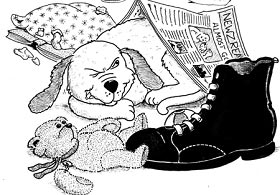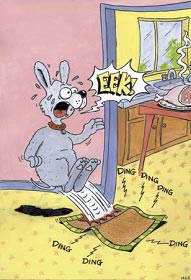What
is the best way to deal with
"stealing" in my
puppy?
Most
puppies love to explore and
chew, so it's no surprise
when a young puppy steals household
objects. When you try to get
these items back from your dog,
a chase ensues because either
the game is fun and the dog
enjoys the attention or because
the dog is reluctant to give
up its new found "treasure".
Pups may raid garbage, steal
food off tables and countertops
and enter cupboards or refrigerators,
where they help themselves to
snacks. Despite owner attempts
at punishment, these behaviors
continue. Why?
 When
dealing with an unwanted behavior,
look for the motivation. Food
items are appealing on their
own. Some puppies steal objects
when they are left unsupervised,
because they have not been directed
to an acceptable activity. Puppies
may continue to steal because
the game of chase is so much
fun. Each of these motivations
has a different treatment. When
dealing with an unwanted behavior,
look for the motivation. Food
items are appealing on their
own. Some puppies steal objects
when they are left unsupervised,
because they have not been directed
to an acceptable activity. Puppies
may continue to steal because
the game of chase is so much
fun. Each of these motivations
has a different treatment.
If
left to their own devices, most
puppies will get into what we
would refer to as "trouble".
It is important to supervise
your puppy at all times. Keep
the puppy with you and in sight.
Be sure that you schedule adequate
play times daily so that you
are helping your puppy engage
in the proper behavior. Arrange
the environment so that the
puppy cannot get to items. For
example, close doors, use barrier
gates, kennel training or motion
sensor devices to monitor where
your pet can go. It might be
helpful to booby-trap objects
with taste aversives or motion
detector alarms (see our handout
on ‘Behavior management
products'), to teach the
puppy to ‘stay away'.
At the same time, non booby-trapped
items should be located nearby
so that the pet learns the safe
and acceptable alternatives
that it is allowed to chew and
play with.
If
your puppy continues to steal
in your presence, the best means
of monitoring and prevention
is to leave a long leash attached,
preferably to a head halter.
Then as the puppy begins to
wander, or puts its nose into
"out of bounds"
areas, a quick pull on the leash
coupled with a "leave
it" command will teach
it to stay away. Bitter sprays
on these objects will prove
to the puppy that these items
are distasteful if it accidentally
gets close enough to put its
mouth on the object. Then, when
there are items that the puppy
is allowed to pick up, use the
command, 'take it'. This ‘take
it' command can even be
extended to the food bowl or
when giving treats or toys to
your dog. Before offering the
toy, treat or food, first have
the puppy sit, and then give
the ‘take it' command
when its time for the reward.
The goal is not only that the
puppy learn the ‘leave
it' command, but also
that the dog learn only to pick
up objects when it has permission
to do so.
If
your puppy is stealing things
because the game is so much
fun, then don't play.
Instead of chasing your puppy
all over the house, try crouching
down and in a happy voice, with
open arms call your puppy to
you. When the puppy looks toward
you, say "good puppy,
come show me!" Keep up
the praise as the puppy approaches.
With a treat, entice the puppy
to come, show the treat and
when the puppy drops the stolen
object, say ‘good dog'.
Make it come closer, sit, and
then give the reward. Of course
once the dog has learned the
‘give' command (below),
then this command should be
used instead.
Most
importantly, never reach for
your puppy in anger after it
has taken something. Remember,
the behavior you want to change
is the stealing, not the cowering
under the table. When you threaten
your puppy in that way, you
risk fear and later aggressive
behavior. In addition, you are
reducing not improving the chance
that your puppy will give up
the item voluntarily. For some
puppies, if you ignore them
when they steal things and try
to engage them in something
else instead, they may "give
up" the object voluntarily.
How
can I stop food stealing in
my absence?
This
usually requires preventing
access to problem areas or using
"booby-traps". Booby-traps
give punishment from the object
while the act is occurring and
are more helpful in correcting
problem behavior. Examples of
these devices are shaker cans®,
Snappy Trainers®, Scat Mats®,
bitter or hot tasting sprays
or electronic avoidance devices
such as motion detectors (audible
or citronella spray) and citronella
spray avoidance units (where
the dog wears the collar and
a transmitter dish activates
the spray if the dog gets too
close (see our handout on ‘Behavior
management products' for
more details). Shaker cans are
empty soda cans that have pennies
in them. By rigging them to
fall easily, they will startle
a dog when disturbed. If the
dog is stealing food items,
they must be made inaccessible.
No amount of punishment will
be sufficient to deter a dog
that has access to a highly
motivating food item.
How
do I teach the "give it"
command?
It
is very useful if you can teach
your puppy how to give up items
with a command but this is not
always easy to train. First,
you need to have the puppy take
something in its mouth (use
the take command). Remember,
if it is something very desirable,
you may have a difficult time
getting the puppy to let it
go. A rawhide chew or rubber
toy may work well. Keep your
hand on the object at first
and once the puppy has grasped
the toy, say ‘give',
take it away and offer a special
food treat. The purpose of this
exercise is to get the puppy
to open its mouth and release
the item. At the same time you
need to say, ‘give it'
so that the action becomes
associated with the phrase.
By repeated pairing of the words
"give it" with the
release of objects, the dog
will learn the meaning of the
words. Continue to practice
until the puppy expects to give
up the toy for the food treat
and then gradually allow the
puppy to have the object a little
longer before using the ‘give'
command and offering the treat.
Over time you can progress to
more difficult items and allow
the puppy to hold onto them
a little longer before giving
the command and offering the
treat. At the end of the session
you can even give the puppy
a special toy such as a food
filled Kong® rather than
a treat as a substitute for
the one you are taking away.
If
you are having difficulty getting
the toy away at even the most
simple step in the program,
then you should a) use a toy
of less value (e.g. rubber,
nylon) b) allow your dog to
grasp onto the toy and then
give the command and begin to
take it away almost immediately
c) prompt the dog to give up
the toy with its favored treat
and d) consider a head halter
and leash for controlling the
head and mouth during training.
Whenever
you train a new command, repetition
and patience are extremely important.
It is not enough to try and
teach 'give it' for 1-2 minutes
one day and expect your dog
to know it the next. It is only
through repetition and practice
that the behavior will become
solidified.
How
can I stop my dog from getting
on the furniture?
This
is another "owner absent"
behavior. In order to control
it, you first need to teach
your pet that going onto the
furniture is not allowed and
that any attempt to go on the
furniture when the owner is
present must be prevented. (A
leash left attached or a remote
citronella collar can be used
to immediately deter or interrupt
jumping on the furniture). If
you cannot supervise, prevent
access by closing doors or baby
gates, or deter the pet from
entering a room or jumping onto
a table using motion detectors,
Snappy Trainers, Scat Mats,
or alarm mats (see our handouts
on ‘Behavior management
products' and ‘Canine
punishment').
This
client information sheet is
based on material written by
Debra Horwitz, DVM, DACVB and
Gary Landsberg, DVM, DACVB.
© Copyright 2002 Lifelearn
Inc. Used with permission under
license. March 11, 2004. |